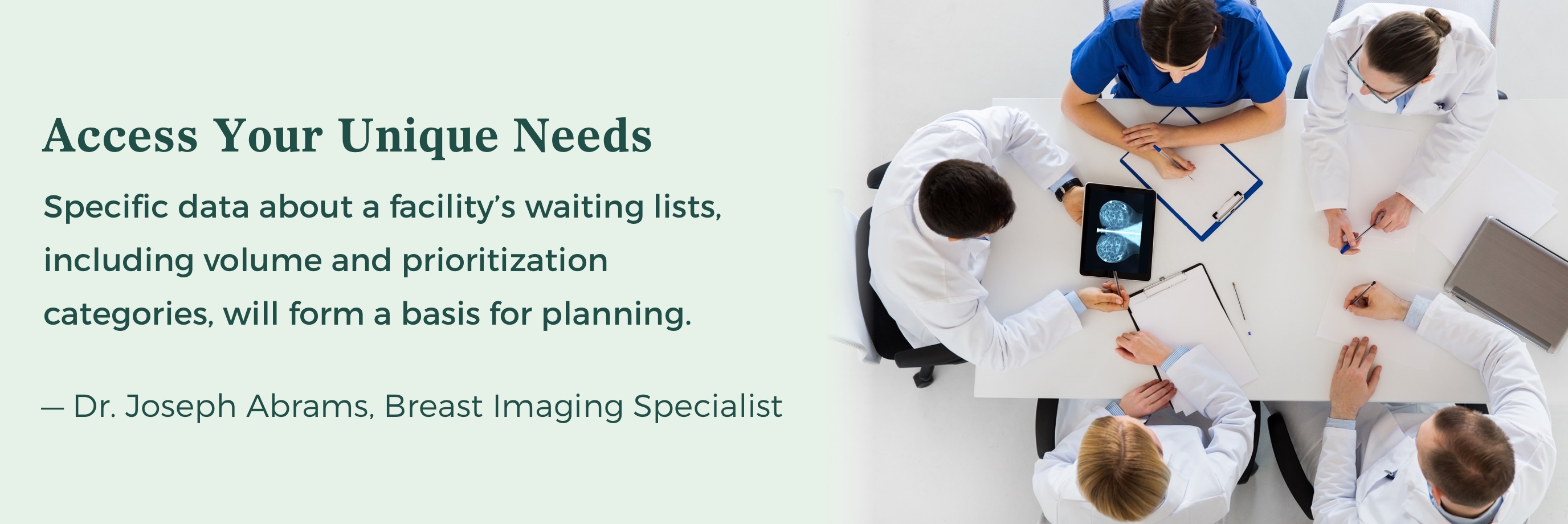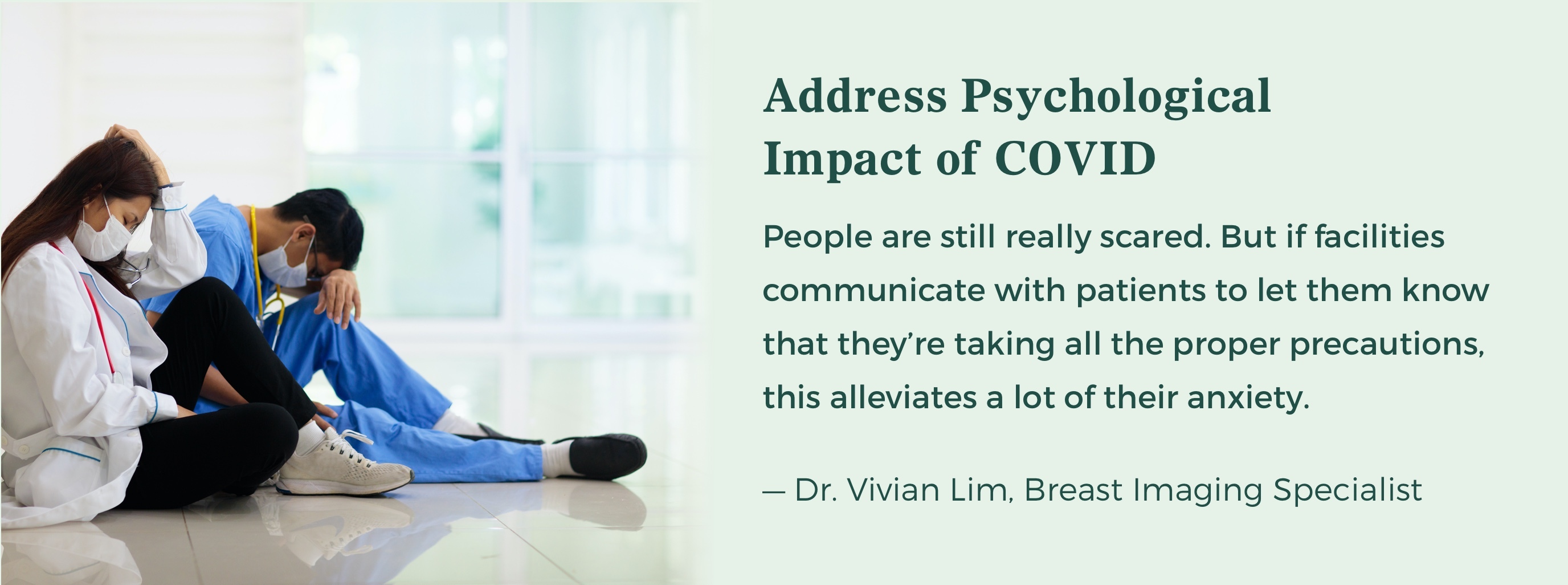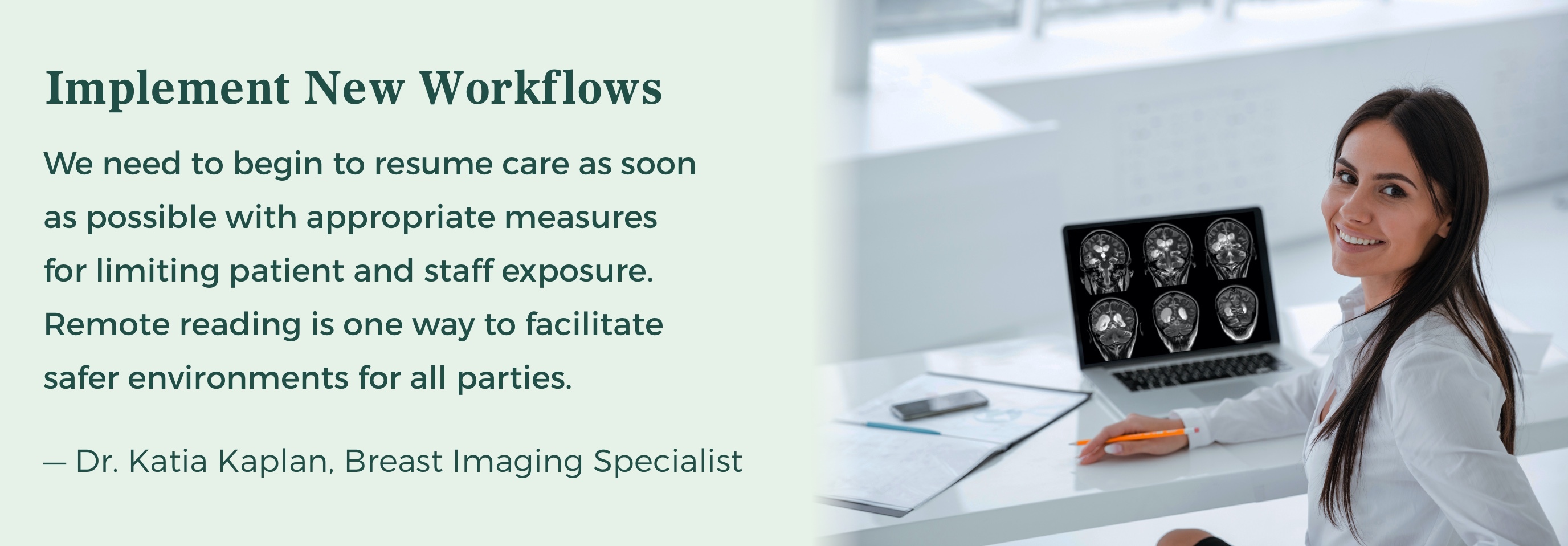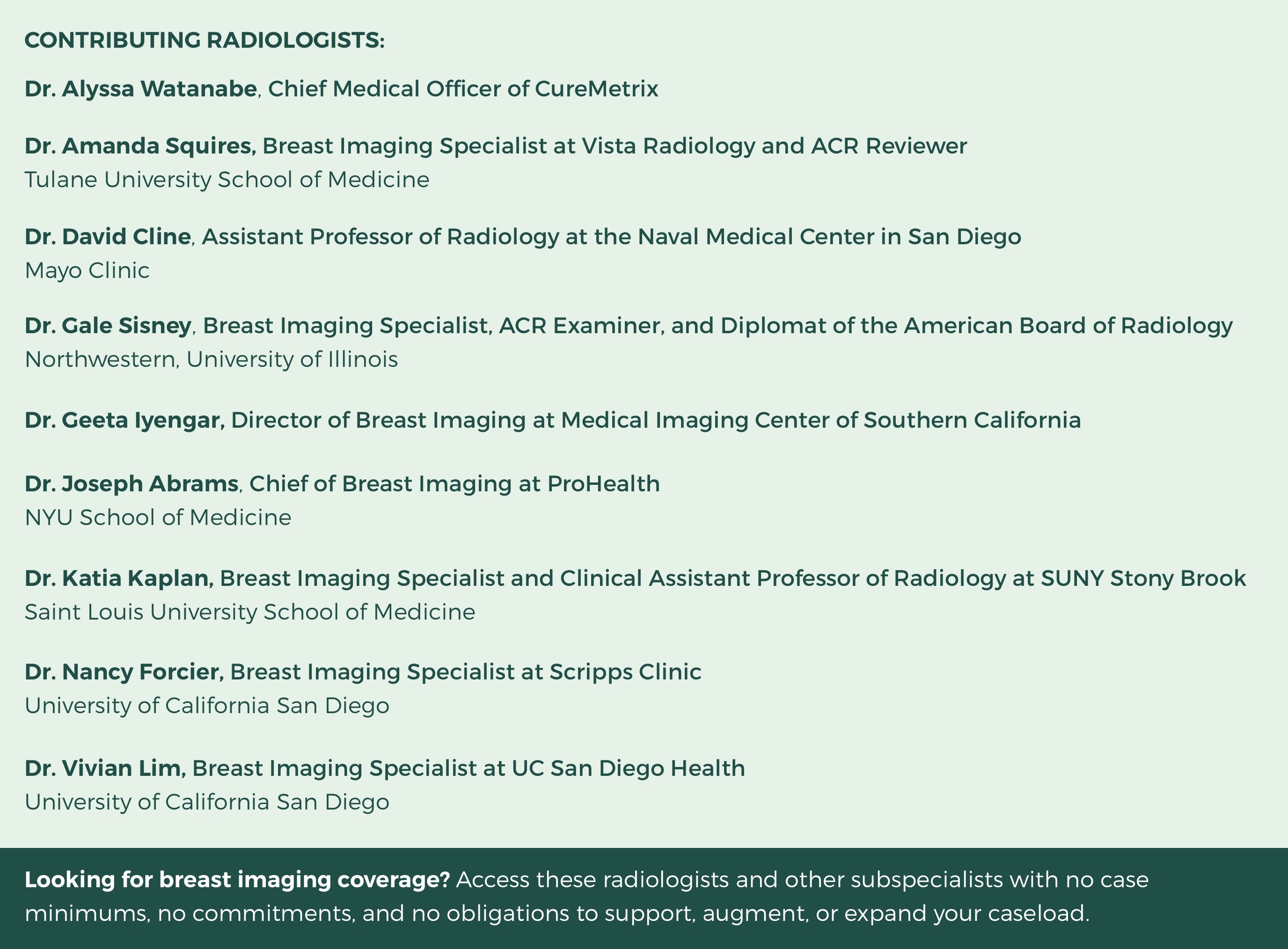It is estimated that as of June, 10 million mammograms have been deferred due to COVID 19 related restrictions.
With a slow lift of lockdowns, this number is expected to grow even higher. As the shift to normalcy begins, practices that offer mammography are beginning to understand the overwhelming responsibility of preparing for recovery. Not letting at-risk patients fall through the cracks, keeping staff and radiologists safe, addressing the psychological impact the pandemic has had on patients, and delivering high-quality breast imaging services are all at the forefront of provider’s minds. Having a plan in place to manage workflow is paramount to successful post-COVID recovery.
“As practices use this downtime to start preparing for the return of patients, communicating internally with breast radiologists, technicians, front office staff, referring providers and patients has taken on new meaning .” – Dr. Gale Sisney, Breast Imaging Specialist at DocPanel and Diplomat of the American Board of Radiology
To better understand the current challenges in mammography, DocPanel radiologists and clients provide insight into the impact of COVID and discuss steps being taken to manage unpredictable volumes, large backlogs, and patient anxiety regarding the safety of returning to doctors’ offices.
1. Pre-Opening Plan
While state laws vary widely depending on the severity of coronavirus impact, practices nation-wide are facing challenges as they figure out the best way to open their doors. Staff layoffs and reduced work hours have created an especially fragile environment, leaving many facilities struggling to implement new workflows to manage new volumes and catch up on backlog.
To assess their unique needs, clinics are conducting honest self-critical assessments of their anticipated patient load, staffing needs, and clinical protocols.
“Groups should assemble a coronavirus panel that includes radiologists, administrators, and technicians, all tasked with prioritizing care post-pandemic. It is important to document each referrer’s preferred means of communication about patients,” says Dr. Joseph Abrams, Chief of Breast Imaging at ProHealth. “Specific data about a group’s waiting lists, including volume and prioritization categories, will form a basis for planning.”
In addition to patient mix, previous and projected procedure mix is being evaluated. For example, practices that perform biopsies may have unique needs as they prepare for higher volumes, and screening mammogram programs embedded in multi-specialty physician offices and are taking into consideration the extra sensitivity they may have sudden high volumes.

“Fear is having a major impact on decision making for patients. Many are choosing to avoid hospitals and other larger diagnostic centers out of concern over increased exposure. As a result, small boutique clinics may now have an edge on attracting patients, especially for screening,” adds Dr. Geeta Iyengar, Director of Breast Imaging at MICSC.
This leaves an opportunity for specialty clinics and imaging centers to address patients’ concerns and create a safe environment for patients to feel comfortable while getting a mammogram.
2. Scheduling Policy
The COVID shutdown is creating a domino effect that impacts scheduling of appointments. Every practice will now have a backlog, and if a surge of volume does occur, phones will be ringing off the hook. Imaging centers are defining new scheduling policies and are training front office staff so that they are ready to execute.
Many facilities are prioritizing procedures and are making lists of all possible biopsy cases so that they can fill those first. Diagnostic mammogram cases that were rescheduled and patients with higher BIRAD scores are being identified and flagged for immediate scheduling. BIRADS 0 callbacks and BIRAD 3 patients with clinical findings, such as palpable abnormalities, are being prioritized for normal working hours with appropriate in-house staff availability. Most practices are planning to reschedule screening mammograms last but ensuring dedicated time slots or days where screening mammograms can continue to happen is important.
“While internal communication is certainly key for smooth scheduling, it’s also important that each patient understands every precaution is being taken to ensure their safety. They should experience a calm and well-organized breast center, from the first phone call to the final result notification,” says Dr. Nancy Forcier, Breast Imaging Specialist at Scripps Clinic & DocPanel.
SUBSPECIALTY RADIOLOGY SOLUTIONS
Grow Your Business with DocPanel
On demand specialty coverage with no contract minimums. Create a free account and get set up and running within 24 hours.
3. Extended Hours of Operation
As breast imaging facilities transition to new standards, appointment times are being doubled to minimize patient numbers in the waiting room and to allow ample time for exam rooms and equipment to be cleaned between patients. Strategies for extending operating hours are also being implemented.
“Offering screening mammogram appointments in the early morning, late afternoon, early evening, and on Saturdays provides patients with an opportunity to visit healthcare facilities at a more desirable time. Clinics are much less busy during these hours, parking is easier, and there’s less activity in general. People are still really scared. But if facilities communicate with patients to let them know that they’re taking all the proper precautions, this alleviates a lot of their anxiety. An extra phone call the day before an appointment can help reassure someone who was contemplating canceling or not showing up,” says Dr. Vivian Lim, Breast Imaging Specialist at UC San Diego Health.
Providers are also choosing to adopt extended hours for screening mammograms and filling normal operating hours with diagnostic mammograms, ultrasound, and other procedures as a way to ensure necessary providers are available at the appropriate times.

“I believe that there are numerous patients that simply won’t come in – open or not – due to concerns for their safety regarding COVID 19. Consequently, there will likely be more later-stage cancers. This isn’t unique to breast imaging and I think the secondary health costs of this will be profound and will likely take years to become fully evident. The best we can do is to be as communicative as possible about all of the steps we are taking to keep patients and staff safe. The truth is – no one knows exactly what to do. No one has all the answers. But we have to take action, as best we can, to take care of patients,” says Dr. Amanda Squires, Breast Imaging Specialist at Vista Radiology and ACR Reviewer.
4. PPE, Social Distancing, and New Workflow
Practices have been inundated with safety advice. Face masks are worn by staff, radiologists, and patients at all times. Waiting room capacities are kept at a 6-10 person maximum and lobbies are being marked off at 6 feet intervals regarding where to stand in line and which chairs are available for sitting. Things like doorknobs, light switches, and keyboards are disinfected at least once or twice a day, and temperature checks are conducted before entering the building. While these measures are certainly essential, breast imaging centers have additional unique challenges to consider as they open their doors to more patients.
“COVID 19 has completely changed the way we operate. Personal contact is limited to only those who are essential to the patient’s care. Clinics are assigning single exam rooms per technologist and single workstations per radiologist. Patients are also no longer allowed to have anyone accompany them to their appointment. And radiologists no longer deliver results in-person when things are normal unless there are specific questions that the tech cannot answer,” says Dr. Amanda Squires, Breast Imaging Specialist at Vista Radiology and ACR Reviewer.

At other facilities, all diagnostic patient results are being delivered over the phone within 48 hours of their appointment.
“The role of the radiologist has expanded because of circumstances created amidst the pandemic. Due to delays in consults as well as scheduling for definitive surgery, radiologists now act as a liaison and a counselor between patients and treating physicians (like surgeons and oncologists) following positive biopsy results. Knowing that the result of your biopsy is positive and being told that treatment will be delayed due to COVID 19 has a huge psychological impact and radiologists need to be able and ready to help patients navigate this difficult period,” says Dr. Geeta Iyengar, Director of Breast Imaging at MICS.
Dr. David Cline, a Mayo Clinic trained breast imager and DocPanel consultant, says every center should also read the new guidelines from The Society of Breast Imaging as well as the American College of Radiology, as both have issued excellent guidance with regards to opening services for screening mammograms.
5. Remote Reads
As breast imaging centers reopen, providers are determining who needs to be physically present in the office, and who can stay at home and work remotely. Some clinics are bringing employees back in phases, and others have teams working on alternating days. Many practices have also moved toward remote reads and are reserving on-site radiologists for diagnostic studies and procedures only.

"Delayed screening increases patient anxiety, delays diagnosis, and, possibly, a life-saving treatment. We need to begin to resume care as soon as possible with appropriate measures for limiting patient and staff exposure and remote reading is one way to facilitate safer environments for all parties,” says Dr. Katia Kaplan, Breast Imaging Specialist and Clinical Assistant Professor of Radiology at SUNY Stony Brook.
By using remote readers with a company such as DocPanel, a platform that provides on demand subspecialty coverage at no contract minimums, facilities can keep turnaround times low and expand their capacity for covergae. Centers are also able to rely on DocPanel radiologists for protocol implementation with techs to increase efficiency and reduce call backs.
To make the transition, practices are setting up remote workstations well in advance. Bandwidth, latency, and internet speed are being adjusted to handle large mammograms and CAD file transfers. With 3D mammogram cases reaching up to 8 GB with priors, any issues can severely limit productivity. As providers prepare for smooth remote processes, they are also ensuring MQSA certification of remote monitors and securing back-up radiologists from reading services and 3rd party PACS if their systems do not support remote reading workflow.
6. Callback Maintenance
COVID 19 has put the spotlight on mammogram callbacks. This has many practices analyzing their callback rates and adopting measures to prevent unnecessary ones in the future. For instance, many clinics are planning pre-opening technician training days to help prevent callbacks due to inadequate image capture. They’re also using these sessions as an opportunity to train on proper documentation protocol for when nonstandard imaging techniques are used.
Strategies for ensuring patient follow-through are also being evaluated.
“In the current climate, patients might be tempted to wait until they experience symptoms, like a palpable lump or nipple discharge, before they get a mammogram or schedule their callback. By then the cancer may be too difficult to treat and cure,” says Dr. Joseph Abrams, Chief of Breast Imaging at ProHealth.
Patients and referrers, he adds, should be reminded that mammography is the most effective weapon in the fight against breast cancer.
“Calling patients that are due or overdue for their callback, annual screening, or diagnostic mammogram to instill confidence that the facility is following the best practice of sanitizing and social distancing will help get women to schedule their appointments,” says Dr. Vivian Lim, Breast Imaging Specialist at UC San Diego Health.
Measures to avoid losing patient history that does not get captured on the tech sheet are also being highlighted. To ensure patients come prepared with prior images and reports for outside studies, pre-appointment phone calls are being added to patient care routines.
SUBSPECIALTY RADIOLOGY SOLUTIONS
Grow Your Business with DocPanel
On demand specialty coverage with no contract minimums. Create a free account and get set up and running within 24 hours.
7. Artificial Intelligence
Artificial intelligence (AI) is happening now and will expand in the future. Many centers have switched to using AI-based CAD (computer-aided detection) due to superior performance and fewer false markings. In addition, workflow optimization with triage software enhances the prioritization of patients who need to be recalled for further workup.
“FDA-cleared cmTriage and solutions like cmAssist AI-CAD aid the mammographer in reading cases with greater ease and support the creation of data-driven, higher accuracy reports," explains Dr. Alyssa Watanabe, Chief Medical Officer of CureMetrix. "In the era of COVID with significant backlogs in breast imaging, the ability for AI to flag the most suspicious and concerning cases first is a huge benefit for practices and their patients.”
As COVID 19 continues to reshape the way health care is accessed and provided, a new normal is being established – but this is uncharted territory for everyone. Creating a safe environment and communicating that to patients, staff, and referring providers are undoubtedly important steps during this transition. While volumes may be unpredictable, a clear plan and implementation of workflows that can support flexibility are sure to prove invaluable.

NEXT UP, READ:
INNOVATIVE DIGITAL BREAST IMAGING HELPS IMPROVE CANCER DIAGNOSES
RADIOLOGISTS ARE MOST QUALIFIED TO EVALUATE BREAST HEALTH
DocPanel is committed to providing imaging centers, radiology groups, hospitals, and physician groups, with on demand specialty coverage at no contract minimums. If you would like to learn more about ways to manage backlog and new volumes, send us a note here and a team member will reach out to you.
